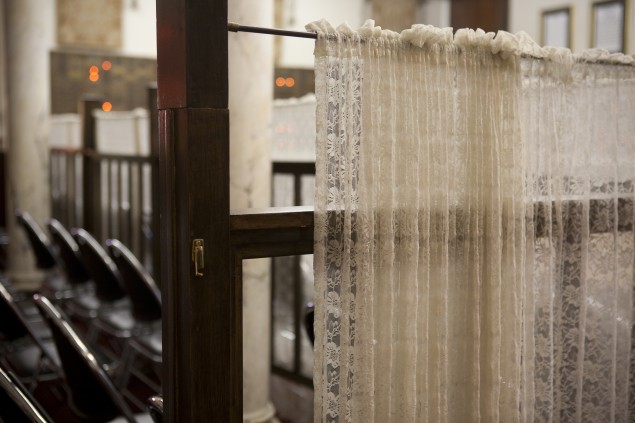Rosh Hashanah Thoughts: Absent Neighborhoods, Absent Tears
In my childhood, a half-century ago in Buffalo’s North Park neighborhood that served as a passage point between the East Side of Eastern European immigrants (mostly Orthodox) and the Amherst- Williamsville suburbs of the upwardly mobile (mostly Reform and Conservative children of the émigré generation), the Jews who chose to join a synagogue had a rich choice within easy walking distance. Most were formal houses of worship with sanctuaries and stained-glass windows: a traditional Orthodox congregation, a Modern Orthodox shul across the street from a large Conservative temple; a few blocks away, another Conservative congregation, and a few more blocks away, yet another Orthodox synagogue.
Then there was the Pine Street Shul, North Park’s only shteibel. It wasn’t on Pine Street. It was on Hertel Avenue, now the gentrified venue of a popular summer Italian Festival, most of Buffalo’s Jews having left years ago for more affluent areas of Western New York or having left Western New York altogether.
The shul’s claim to fame: Samuel Arluck, father of Wizard of Oz-composer Harold (nee Hyman) Arlen, was chazzan and choir director at the Pine Street Shul.
My grandfather died on the stairs of the shul two years before I was born.
When the neighborhood changed, the Pine Street Shul closed down, was sold to a church, and a new incarnation opened up several miles away on Hertel Avenue to serve the aging congregants who had relocated to North Buffalo. The Pine Street Shul’s new home was a converted, twostory wooden house.
My parents, during the years of my Bar Mitzvah training, belonged to the area’s major Conservative temple, but I occasionally set foot in the Pine Street Shul, usually on Rosh Hashanah. That’s where my grandmother davened, not that I knew the term daven in those days.
I listened to the sound of unabashed, unrestrained sobbing . . . It sounded like a funeral. Then, I didn’t understand. Now, I do.
Goldie Finkelstein, from a shtetl in Western Belarus, a widow for two decades, was a typical member of the Pine Street Shul. A simple God-fearing woman who had crossed the ocean in 1904, she raised a family and kept her faith in Buffalo. Yiddish-speaking, kosher-keeping, sheitel-wearing, Mrs. Finkelstein walked the few blocks on the High Holy Days from her home on the second story of my parents’ house to the cramped building where her landsleit prayed. Occasionally, she invited me. I went with her a few times; curious, I guess.
My memories of those days are hazy. Some all-Hebrew prayer books that I didn’t understand. An all-Hebrew service that was also foreign to me. A gauze curtain that separated the women’s section, in the rear, from the men’s section, in the front.
I remember the crying. Mainly, from the women’s section.
As I read the few words I understood and watched the old men in beards shuckling; I listened to the sound of unabashed, unrestrained sobbing from faces I couldn’t see. I always supposed that my grandmother was one of the lachrymose petitioners. It sounded like a funeral. Then, I didn’t understand. Now, I do.
The women were standing before God.
They were opening their hearts. They weren’t reading words from a machzor; they were speaking from their souls. They were confessing their sins and begging for Heavenly forgiveness. Approaching the end of their lives, they were seeking health and longer days. To them, it was more Day of Judgment than yom tov. They were praying like a Jew should pray during the Days of Repentance.
Praying in a way that I, a ba’al teshuvah for thirty years, have never done, do not approach, cannot imagine. That was how they and their parents before them had prayed in the shuls of their homelands. That was how, according to rabbinical literature, a Jew behaves when the verdict on his or her life is being rendered in the Heavenly Court.
I pray each year on the High Holy Days in Orthodox synagogues and yeshivot where tefillah is taken seriously, where the shofar is blown with kavanah, where stirring Shabbat Shuvah derashot are delivered. But I have never cried on Rosh Hashanah, never become like the mitpallelim I remembered from the Pine Street Shul.
Buffalo’s East Side, the section known as the Fruit Belt for its street names, is long gone as a Jewish neighborhood, a memory like Oz.
The North Park neighborhood? With two exceptions, all the synagogues there are gone too, mostly turned into churches; one Orthodox shul remains as it was; one Conservative congregation is now a Chabad center. A shopping plaza now stands where the Pine Street Shul once did. Neighborhoods change or move or disappear. Buildings come and go. I don’t mourn their passing.
But tefillah, especially on the holiest days of the year, is as eternal as the Creator to whom we offer our prayers. Why don’t we–why don’t I–feel the gravity of these days as our grandparents and their parents did?
When I stand in shul each Rosh Hashanah, I think of the Pine Street Shul. I keep in mind that the Gate of Tears never closes. I think of Channah, the mother of the prophet Shmuel, whose cries serve as the model of our tefillot. I recall the Arizal’s opinion that something is missing in the neshamah of someone who doesn’t shed tears on the holiest of days. But no matter how intensely I prepare for this period of introspection, no matter how many books of mussar I review, no matter what exercises of spiritual improvement I perform, no matter the litany of sins I admit with my lips and my heart, no matter my attempts in shul to imagine myself standing before The Judge, my eyes remain dry.
Still, I don’t bring myself to cry.
And that may be most deserving of tears.
Steve Lipman is a staff writer for the Jewish Week in New York.

